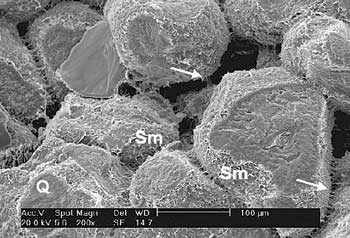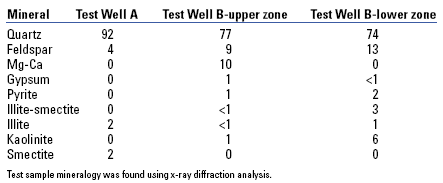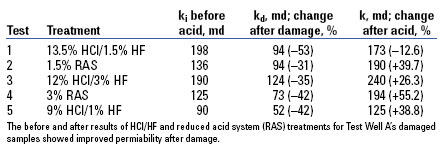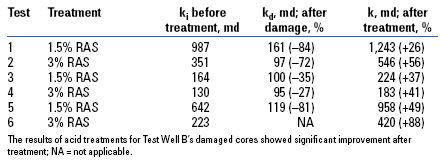Production Technology
Realistic core testing improves sandstone acid treatment
Flow testing of damaged cores proves acid's ability to remove real-world damage.
Syed A. Ali, Chevron Energy Technology Co.; Carolyn DeVine, Leonard Kalfayan and Chike Uchendu, BJ Services Co.
Core flow testing has long been an accepted method for assessing formation sensitivity to treatment fluids and evaluating sandstone matrix response to acidizing treatments. However, core flow tests are often conducted with standard core material like Berea sandstone, rather than the actual formation core. Furthermore, test procedures typically use undamaged cores.1, 2, 3
Studies with undamaged cores can be meaningful in assessing rock's sensitivity to particular acid formulations, including the severity of acid/ formation reaction-product re-precipitation. However, in evaluating effectiveness of specific hydrofluoric (HF) acid systems for removing permeability damage and limiting formation acid sensitivities, testing undamaged cores is not sufficient.
A systematic approach to core flow testing uses procedures that damage cores in a manner representing realistic damage mechanisms, then remove damage with appropriately selected HF treatment systems (and non-acid, pre-acidizing treatment systems, if necessary). The degree of damage removal and stimulation is measured after each treatment step. Comparing test results then allows selection of the most cost-effective damage removal and acid treatment solution.
This method was part of a study to design acid stimulations for three mineralogically dissimilar reservoir zones in two wells. The goal was to determine which of several acid systems would maximize damage removal.
LABORATORY PROCEDURES
Before core flow testing, mineralogical evaluation begins the acid-system, candidate-selection process for core flow testing. For example, it may be useful to test mechanical properties such as Young's Modulus (YM) of elasticity by nondestructive methods, before and after acid treatment, to assess the effect of acid on rock strength: Significant rock strength weakening may indicate reduced competence of the grain framework.
A nondestructive, dynamic method was used to quantify elastic moduli. The method involves carefully measuring the bulk density, compressional wave velocity and shear wave velocity in each core sample, then calculating dynamic Poisson's ratio and YM from standard equations.
For acid treatment, candidate core samples were analyzed using both bulk (whole sample) and fine (clay-size fraction) x-ray diffraction analysis. Sample portions were gently crushed, and crushed material was thoroughly mixed. Half of the crushed material was ground to a fine powder, loaded into a standard sample holder and scanned with Cu-Ka radiation through a diffraction angle of 2° to 60° 2U. Bulk sample chemistry was then determined by x-ray fluorescence analysis to fine-tune the interpretation. The second portion of the crushed mixture was treated to remove organic material and reduced iron. After treatment, the clay-size fraction was separated and analyzed in both air-dried and glycolated states.
A small chip of one sample from Test Well A was cleaned using toluene vapor extraction, dried at 150°F overnight, affixed to a standard aluminum scanning electron microscope (SEM) stub, and coated with gold. The sample was then placed in the SEM vacuum chamber to ascertain the distribution of clay minerals and other authigenic cements in the pore system, and the pore system morphology (pore sizes and degree of open-pore interconnection).
CORE FLOW ANALYSIS
Residual hydrocarbon and other contaminants were removed from newly submitted plugs, using the toluene vapor extraction technique, until fluid in contact with cores was colorless. After cleaning, plugs were dried at 150°F for 13 hr. Suction was applied to plug surfaces to remove residual fines from surface pores. Porosities were determined using a dual-cell Boyle's Law porosimeter and helium gas, and nitrogen gas baseline permeability was established for each plug. These tests were conducted at room temperature with 400-psi confining pressure.
Test Well A core flow procedure. Plugs were seated in rubber sleeves at 1,500 psi confining pressure and flow-saturated with filtered 2% NH4Cl solution containing a water-wetting surfactant and a mutual solvent to ensure that the sandstone cores were in similar initial water-wet state before acid treatment. Before flow, the system was heated to 195°F reservoir temperature.
Flow was established in an arbitrary formation-to-wellbore (production) direction with humidified nitrogen gas and taken to steady-state permeability. To simulate perforation tunnel damage, cores were injected with a silica flour and smectite slurry in the reverse (injection) direction.
Treatment fluids were also injected in the reverse direction:
- Pre-flush acid (2.5 pore volumes)
- Main acid treatment (four pore volumes)
- Post-flush acid (2.5 pore volumes)
- Displacement fluid.
Effluent fluids were collected for each flow test at one-pore-volume intervals. Samples were analyzed using direct current plasma analysis for Al, Si, Ca, Mg, K, Na, Fe and P ion contents, providing information about acid dissolution of mineral phases and insight into potential reaction by-product re-precipitation.
Final treatment fluid was displaced from the core with humidified nitrogen gas. Flow was re-established in the production direction with humidified nitrogen gas to steady state.
Test Well B core flow procedure. Before core flow testing with formation cores, several pilot tests used Berea cores with permeabilities similar to anticipated formation permeability to test the feasibility of damaging the rock with slurry. Pilot tests were encouraging, and testing proceeded to formation cores.
Pre-analysis preparation began as in Test Well A, except that the system was heated to 175°F reservoir temperature, and flow was established in the production direction to steady-state permeability using standard oil.
Formation cores were then slurry-damaged, as for Test Well A, with a few modifications. After establishing a damaged permeability, fluid systems were injected in the reverse direction, as before:
- Organic pre-flush
- Pre-flush acid (two pore volumes)
- Main acid treatment (five pore volumes)
- Post-flush acid (two pore volumes)
- Displacement fluid
Effluent fluids were collected for each flow test at one-pore-volume intervals and analyzed as before. The final injected fluid stage was then displaced from the core with an ammonium chloride solution. Flow was re-established in the production direction with standard test oil to steady state.
MINERALOGY
Test Well A. The sample examined with SEM is a fine- to medium-grained, moderately well-sorted quartz arenite. Smectite occurs as a thin rim on most quartz grains. Quartz overgrowths are present on those portions of quartz grains that are not rimmed by clay. Much of the original porosity and permeability has been preserved because of the minimal quartz-overgrowth precipitation.
Smectite bridges pore throats locally. Illite and smectite appear to be inter-grown, and the illite appears to be fibrous. Pores are large (~100 micron) and well-interconnected through a network of open pore throats, Fig. 1 and Table 1.
 |
Fig. 1. This photomicrograph from a Test Well A sample shows smectite (Sm) coating quartz (Q) grains, bridging pore throats (arrows) and partially filling pores.
|
|
| TABLE 1. Test sample mineralogy. |
 |
|
Test Well B. Samples from two sand bodies were examined. The shallower samples are fine-grained sandstones with depositional shale either dispersed throughout the rock or occurring as clasts (rounded fragments).
Samples from the deeper sand are laminated, with fine-grained, porous and permeable sandstone laminations separated by discrete depositional shale laminations. The shale fraction appears to increase with depth, Table 1.
ELASTIC PROPERTIES
Pre- and post-acidization elastic properties were determined for cores acidized from Test Well A, Table 2. Results indicate that the YM is essentially unchanged after acidization. The rock density is, in all cases, slightly reduced.
| TABLE 2. Acidization results. |
 |
|
CORE FLOW ANALYSIS
Test Well A. Baseline porosity and permeability testing revealed that porosities ranged from 15.6% to 19.1%, and dry nitrogen plug permeabilities, as received, ranged from 91 md to 585 md. This portion of the interval represented by these plugs was of good quality.
Core flow testing generated permeability and rock dissolution data for five acid systems: 12% HCl/3% HF, 9% HCl/1% HF, 13.5% HCl/1.5% HF, half-strength (1.5%) retarded acid system, and regular-strength (3%) retarded acid system, Table 3.
| TABLE 3. The results of acid treatments for Test Well A’s damaged samples. |
 |
|
Conventional HCl/HF systems. The treatment, 13.5% HCl/1.5% HF with 15% HCl as preflush and postflush, removed most of the slurry damage, Fig. 3. The final permeability after treatment is 12.6% less than the original undamaged permeability, possibly because of phase re-precipitation or fines migration. Effluent samples of preflush acid were rich in calcium and held silicon and aluminum, suggesting that the pre-flush acid affected the Ca-montmorillonite.
Effluent samples of the main acid contained potassium, indicating dissolution of formation feldspar and illite. The aluminum content suggested further dissolution of Ca-montmorillonite with, possibly, formation feldspar. The silicon content suggests partial dissolution of silica flour, quartz and feldspar. Effluent analyses cannot confirm the damage mechanism.
The 9% HCl/1% HF acid system produced a higher overall permeability response than the 12% HCl/3% HF acid, but lower than the 3% RAS. Effluent samples taken during the plug's damage-removal treatment with the 9% HCl/1% HF acid contained silicon and aluminum, indicating that it is equally effective in extracting aluminum and silicon from clays and siliceous particles.
Retarded acid systems. Data from the 1.5% RAS test show that this system removed the laboratory-induced damage and improved the core permeability. Effluent samples taken during damage removal indicated that this acid system extracted more silicon and less aluminum than conventional acid systems. This result was expected because the retarder component (organo-phosphonate complex) has a strong affinity for metals, giving it a strong attraction to alumino-silicates such as clays and feldspars.4, 5, 6 This reduces the HF acid reaction with these minerals and enhances its reactivity with quartz and silica fines. As a result, RAS may penetrate deeper into the formation than conventional HF acids.
Among the acid systems tested, 3% RAS achieved the best damage removal and enhanced return permeability. Effluent samples taken during damage removal indicated a higher dissolution of siliceous particles and controlled dissolution of clays and feldspar. Treatment with 3% RAS yielded a final permeability twice that recorded after treatment with 12% HCl/3% HF conventional acid. RAS provided a higher degree of siliceous particle dissolution, although the conventional acid had higher combined dissolution of clays and siliceous particles.
Test Well B. Because Test Well B contains abundant depositional shale, there was concern that conventional acid systems might cause disaggregation of the formation near the wellbore. Moderated and deeper-penetrating acid reaction was desired, limiting the testing to RAS. Three core flow tests were performed with the 1.5% RAS, and all showed that the system is effective in both removing laboratory-induced damage and enhancing core permeability. Permeability increases ranged from 26% to 49% above original, undamaged permeabilities, Table 4. Effluent samples, taken during damage removal, indicated that this acid system extracted more silicon and less aluminum than conventional acid systems, as expected.
| TABLE 4. The results of acid treatments for Test Well B’s damaged cores. |
 |
|
Three core flow tests were performed with 3% RAS, and all showed that the system is effective in removing laboratory-induced damage and enhancing core permeability. Permeability increases ranged from 41% to 88% above original, undamaged permeabilities, Table 4. The increase in permeability beyond the undamaged state is not so high as to indicate excessive formation dissolution. Effluent samples taken during the damage removal phase indicated high siliceous particle dissolution and controlled dissolution of clays and feldspar.
Treatment with 3% RAS yielded final permeabilities greater than those from treatment with 1.5% RAS, probably because of the higher degree of siliceous particle dissolution. Results of the 3% RAS test indicated a controlled, uniform dissolution, implying deeper acid penetration.
FIELD RESULTS
BJ engineers in Nigeria developed a treatment plan, validated by these studies, for a series of injector wells in the fields around Test Wells A and B. In the first field with analogs to Test Well A, they planned to use RAS with workstring reciprocation and treated three wells:
- Initial injection was 700 bwpd at 1,000 psi. Injection after treatment was 2,160 bwpd at 440 psi but dropped to 1,500 bwpd at 1,100 psi shortly afterward. The unexpected decline was likely caused by unclean lines/ tubing.
- Injection before treatment was zero. Injection after treatment was 2,160 bwpd at 1,500 psi, dropping to zero shortly afterward. The last fluid returns before treatment appeared to be rusty, so the engineers suggested future treatments should include pickling lines/ tubing with solvent/ acid systems.
- Injection before treatment was 720 bwpd at 1,100 psi. Injection after treatment rose to 3,168 bwpd at 1,200 psi. Treatment did include a pickling step; however, the treatment was not as successful as hoped because the coiled tubing workstring was not reciprocated during the treatment.
Based on the lessons learned, the engineers moved to the field containing Test Well B with an altered plan to pickle the tubing with xylene-HCl before treating the well with RAS through coiled tubing. Four wells were treated:
- Injection before treatment was 4,500 bwpd at 1,400 psi. Injection after treatment was 7,500 bwpd at 1,100 psi.
- Injection before treatment was 6,300 bwpd at 1,050 psi. Injection after treatment was 8,800 bwpd at 500 psi.
- Injection before treatment was 2,800 bwpd at 1,300 psi. Injection after treatment was 6,400 bwpd at 1,200 psi.
- Injection before treatment was 4,700 bwpd at 1,200 psi. Acid treatment was aborted because the pickling treatment removed emulsion/ rust that apparently was reducing the injectivity. Injection after treatment was 9,000 bwpd at 1,260 psi.
CONCLUSIONS
Core flow tests evaluating sandstone acidizing should be conducted with damaged formation cores to more properly evaluate and compare HF acid systems. However, results should only be used for comparative purposes, not as absolute indicators of field performance.
In the tests, the 3% RAS provided the best overall permeability response because:
- HF reaction is moderated, shown by a stable YM
- Clay dissolution is reduced
- Siliceous particle dissolution is enhanced
- Detrimental effects are mitigated through complexation of metal ions in solution by the organo-phosphonate complex retarder.
Although the 3% RAS yielded the best results in this study, such agreement is not always the case. Similar test procedures should be followed for new wells in an exploration area, or for existing wells in areas without a history of successful HF acidizing. This will give greater confidence when selecting the most effective HF acid treatment. 
ACKNOWLEDGMENTS
The authors thank BJ Services Co. and Chevron Corp. for permission to publish. A special thanks goes to Dr. Gerald Braun for Well B's x-ray analyses, to Dr. Russell Maharidge for Test Well A's elastic property determination, to BJ Services' analytical laboratory for DCP testing and analysis and to Stephanie Weiss for helping prepare this article. This article was developed from technical publication 2002-288, which was presented at the Canadian International Petroleum Conference, Calgary, Alberta, Canada, June 11 – 13, 2002.
LITERATURE CITED
1 Hsi, C. D., S. L. Bryant and R. D. Neira, "Experimental validation of sandstone acidization models," SPE 25212, presented at SPE International Symposium on Oilfield Chemistry, New Orleans, LA, 1993.
2 Nasr-El-Din, H. A. and H. A. Al-Anazi, "Acid/ rock interactions during stimulation of sour water injectors in a sandstone reservoir," SPE 37215, presented at SPE International Symposium on Oilfield Chemistry, Houston, TX, 1997.
3 Asadi, M., F. W. Preston, D. W. Green and A. Ghalambor, "Effect of the perforation damage on well productivity," SPE 27384, presented at SPE International Symposium on Formation Damage Control, Lafayette, LA, 1994.
4 Di Lullo, G. and P. Rae, "A new acid for true stimulation of sandstone reservoirs," SPE 37015, presented at SPE Asia Pacific Oil and Gas Conference, Adelaide, Australia, 1996.
5 Dean, G. D., C. A. Nelson, S. Metcalf, R. Harris and T. Barber, "New acid system minimizes post acid stimulation decline rate in the Wilmington field, Los Angeles County, CA," SPE 46201, presented at SPE Western Regional Meeting, Bakersfield, CA, 1998.
6 Kume, N., R. Van Melsen, L. Erhahon and A. F. Abiodun, "New HF acid system improves sandstone matrix acidizing success ratio by 400% over conventional mud acid system in Niger delta basin," SPE 56527, presented at SPE Annual Technical Conference and Exhibition, Houston, TX, 1999.
|
THE AUTHORS
|
 |
Syed A. Ali earned an MS degree from Ohio State University and a PhD degree from Rensselaer Polytechnic Institute. He has 30 years' experience in the oil and gas industry with specialization in sandstone acidizing, formation damage control, rock-fluid interaction, mineralogy and oil field chemistry. Ali is a research consultant for Chevron Energy Technology Co. in Houston. He serves as an executive editor for SPE Production & Operations and is on the Program Committee for the 2006 SPE Annual Technical Conference and the 2006 SPE Formation Damage Control Symposium.
|
|
 |
Carolyn DeVine earned degrees in chemistry, geological sciences, geochemistry, and civil engineering (flow through porous media). During her career, she has taught at the college and university levels, worked for the US Army Corps of Engineers, PB-KBB, and David K. Davies & Associates. DeVine is leader of the Special Core Analysis Group at BJ Services Co., Tomball Technology Center. She has authored and co-authored over 30 papers in fields of acidizing, fracturing, water sensitivity, formation damage and remediation, and groundwater contaminant transport.
|
|
 |
Leonard Kalfayan earned a BA degree in chemistry from Occidental College and an MS degree in chemical engineering from Purdue University. He joined BJ Services in 1998 after being with Unocal for 15 years and an independent consultant for four years. He is presently BJ Services' product line technology manager, Production Enhancement, supporting acid stimulation, water management, and remedial services. He was an SPE 2004 – 05 distinguished lecturer and chairman of the 2006 SPE Annual Technical Conference Stimulation Sub-committee. Kalfayan is author of Production Enhancement with Acid Stimulation (PennWell 2000).
|
|
 |
Chike Uchendu earned a BS degree in mechanical engineering from the University of Nigeria in 1989. He held field engineering and management positions with oil and gas service providers before joining BJ Services in 1998. Uchendu supports coiled tubing, cementing, sand control and stimulation applications in Nigeria for land, swamp and offshore operations. He is engineering manager for BJ Services Co. Nigeria Ltd. in Port Harcourt. Uchenda is an active SPE member and has written and co-authored numerous technical papers.
|
|
|











